Introduction
If you’re new to SEO (Search Engine Optimization), this guide will walk you through everything you need to know—from the basics to advanced strategies. By the end of this guide, you’ll understand how to improve your website’s visibility on search engines like Google.
SEO is a crucial aspect of digital marketing that helps businesses grow online by increasing their search engine rankings. Understanding SEO can be overwhelming at first, but once you learn the fundamental techniques, you can apply them to any website to generate more traffic and engagement. This guide is designed for beginners who want to master SEO from scratch and gradually move towards more advanced techniques.
What is SEO?
SEO is the practice of optimizing your website to rank higher in search engine results pages (SERPs). The goal is to attract organic traffic by improving the quality and relevance of your content. It involves a combination of keyword research, content creation, and technical improvements to ensure that search engines recognize and rank your website appropriately.
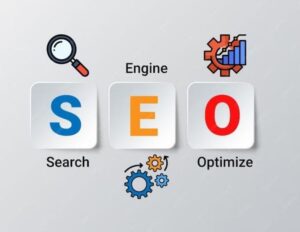
Importance of SEO
- Increases Website Traffic: Higher rankings lead to more visitors to your site.
- Builds Credibility and Trust: Websites that rank high are perceived as more authoritative.
- Enhances User Experience: Good SEO practices improve site usability and navigation.
- Provides Long-Term Results: Unlike paid ads, SEO continues to bring traffic over time.
- Better Conversion Rates: SEO-optimized sites tend to have better engagement and conversion rates.
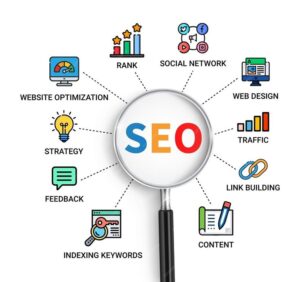
Key Components of SEO
1. On-Page SEO
On-page SEO refers to optimizations made directly on your website. This includes:
- Title Tags: Use unique and keyword-rich titles for each page (
<title>Your Page Title</title>in HTML). - Meta Descriptions: Provide a short summary of your page’s content (
<meta name="description" content="Your description here">in HTML). - Header Tags (H1, H2, H3, etc.): Use structured headings for better readability and SEO ranking.
- URL Structure: Keep URLs clean and include relevant keywords.
- Internal Linking: Link to other relevant pages on your website to improve navigation.
- Image Optimization: Use descriptive alt text (
<img src="image.jpg" alt="Image description">) and compress images to enhance load speed. - Content Readability: Use short paragraphs, bullet points, and headings to improve user experience.
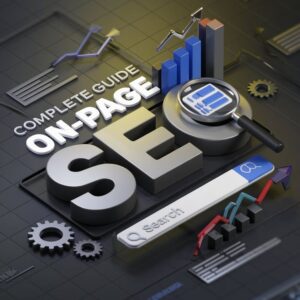
2. Off-Page SEO
Off-page SEO involves activities done outside your website to improve its authority and ranking.
- Backlink Building: Get high-quality backlinks from reputable websites.
- Social Media Marketing: Share your content on social platforms to increase engagement.
- Guest Blogging: Write guest posts for industry-related blogs.
- Brand Mentions: Gain recognition by having other sites mention your brand.
- Forum Participation: Engage in relevant forums and communities.
- Influencer Outreach: Collaborate with influencers for brand promotion.
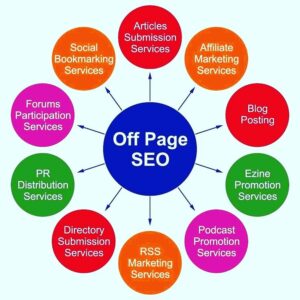
3. Technical SEO
Technical SEO ensures that search engines can easily crawl and index your site.
- Site Speed Optimization: Use tools like Google PageSpeed Insights to improve load time.
- Mobile-Friendliness: Ensure your site is responsive on all devices.
- XML Sitemaps: Submit a sitemap to search engines to help them discover your pages.
- Robots.txt: Control which pages search engines should or shouldn’t crawl.
- Structured Data (Schema Markup): Helps search engines understand your content better.
- Canonical Tags: Prevent duplicate content issues by specifying the preferred URL.
- HTTPS Security: Ensure your website uses SSL for better rankings and security.
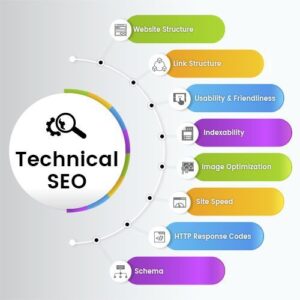
4. Content Optimization
Content is the backbone of SEO. Follow these strategies:
- Keyword Research: Use tools like Google Keyword Planner and Ahrefs to find relevant keywords.
- High-Quality Content: Write in-depth, valuable content that answers user queries.
- Use Multimedia: Include images, videos, and infographics to make content engaging.
- Optimize for Featured Snippets: Structure content in a way that Google can pull as a direct answer.
- Regular Updates: Keep content fresh by updating old posts with new information.
- Content-Length Optimization: Longer, in-depth articles tend to perform better in search rankings.
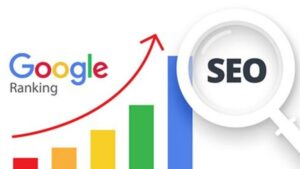
Where to Use Images in SEO?
Images make content visually appealing and improve user engagement. Use them:
- Attractive Feature Image: At the beginning of blog posts.
- Throughout the Content: For explanations, examples, and infographics.
- Alt Tags for SEO: Ensure every image has an appropriate alt tag for better rankings.
- Optimized File Names: Use descriptive file names instead of generic ones (e.g.,
seo-tips.jpginstead ofimage1.jpg).

Where to Use HTML Elements?
- Title Tags (
<title>): In the<head>section of your webpage. - Meta Descriptions (
<meta>tags): In the<head>section. - Header Tags (
<h1>,<h2>,<h3>, etc.): To structure content properly. - Paragraph Tags (
<p>): To separate blocks of text. - Image Tags (
<img>): Where images are used. - Anchor Tags (
<a href="URL">Link Text</a>): For internal and external links. - List Tags (
<ul>,<ol>): To present information in an easy-to-read format. - Table Tags (
<table>): To organize complex data.
Advanced SEO Strategies
Once you understand the basics, move on to advanced techniques:
- Schema Markup: Helps search engines understand your content better.
- Voice Search Optimization: Optimize for voice searches by using natural language.
- Core Web Vitals: Improve user experience by focusing on speed, responsiveness, and visual stability.
- E-A-T (Expertise, Authoritativeness, Trustworthiness): Build credibility by providing high-quality content.
- Local SEO: Optimize your site for local searches by using Google My Business and location-based keywords.
- Content Clusters: Organize your content around pillar pages and topic clusters for better SEO.
- AI and SEO: Use AI-driven tools for keyword research, content generation, and analytics.
- Video SEO: Optimize YouTube videos with proper titles, descriptions, and tags.
- International SEO: Target global audiences by implementing hreflang tags and localized content.
- User-Generated Content: Encourage reviews and comments to improve engagement.
- SEO Automation: Use automation tools to track rankings, audit websites, and generate reports.
Common SEO Mistakes to Avoid
- Keyword Stuffing: Overloading content with keywords leads to poor readability.
- Ignoring Mobile Optimization: Mobile-first indexing is crucial for rankings.
- Slow Page Speed: Pages that take too long to load lose visitors.
- Poor Quality Content: Thin or duplicate content negatively affects rankings.
- Not Using Analytics: Track performance using tools like Google Analytics and Search Console.
- Neglecting Technical SEO: Failing to optimize crawlability and indexability.


